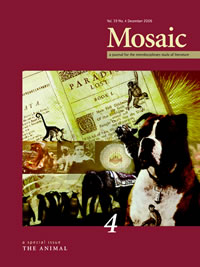Issue 39.4
Overview

Special Issue: The Animal - Part I
Published: December 2006
View the issue introduction or see the issue summary and contents below.
12 essays, totalling 224 pages
$22.95 CAD
This, the first of two Mosaic special issues on "the animal," includes essays on a broad range of topics: bears as postcard subjects; animal rights theory; literary anthropomorphism; the figure of the beast as significant for political theory and practice; the physics and metaphysics of caging; zoosemiotics in georgic poetry; interspecies ambivalence in Coetzee's fiction; Rachel Rosenthal's performance art; imaginary animals in Ishiguro and Coetzee; Nietzsche's animal menagerie; South African poems about elephants. This is an explorative issue that contributes importantly to an emerging field.
Rachel Rosenthal Is an AnimalH. Peter Steeves Animality is at the core of much of Rachel Rosenthal’s performance art and painting. Looking to the work of Rosenthal (as well as Plato, Shakespeare, Rauschenberg, and others), this essay is an attempt to understand the intricate relationships among the artist, the animal, the audience, and the notion of performance itself. | |
Why Write a Poem about Elephants?Dan Wylie A close reading of selected Southern African poems about elephants provides a window onto interdisciplinary readings of southern African ecocritical issues generally, involving three interlocking aspects: local ecological realities, especially managerial conservation ethics; the animal-human interface as it emerges in anthropomorphic expression; and a cautious, even self-ironizing, articulation of beauty and mystery. | |
Taming the Beast: The Other Tradition in Political TheoryMichael Marder Throughout the history of Western metaphysics, the figure of the beast has been excluded from the realms of the thinkable and the doable, even as it constituted these realms. This essay aims to outline the trajectory of such exclusion and to invest the figure of the beast with renewed significance for political theory and practice. | |
Nietzsche’s Animal Menagerie: Lessons in Deep EcologyJoseph P. Vincenzo By way of a philosophical examination of select animal images from Nietzsche’s animal menagerie, Thus Spoke Zarathustra, this essay develops the thesis that Nietzsche’s animal images provide lessons in deep ecology insofar as they serve to move Zarathustra and the reader through the critical transformations necessary for remaining faithful to the earth. | |
“The Bears are Plentiful and Frequently Good Camera Subjects”: Postcards and the Framing of Interspecies Encounters in the Canadian RockiesKeri Cronin The following essay considers the role of animal imagery on postcards marketed in Canada’s Rocky Mountain Parks. These popular souvenir items have helped shape dominant systems of environmental knowledge. Because of this, postcards should be considered in discussions regarding the ecological health of the region. | |
An Ecocritical Approach to Horacio Quiroga’s “Anaconda” and “Regreso de Anaconda”Bridette W. Gunnels This essay studies the two sister tales “Anaconda” and “Regreso de Anaconda” by Horacio Quiroga using an ecocritical approach. By questioning specifically the anthropomorphization of the animal protagonists, the essay illuminates ecocritical tenets as well as acknowledges the issues of animal rights theory as viewed through both tales. | |
Animal Signs and Ethical Significance: Expressive Creatures in the British GeorgicTobias Menely This essay locates in eighteenth-century georgic poetry an attention to zoosemiotics, which interrupts the logo-centric practice of making the animal’s ostensible silence grounds for ethical exclusion, and anticipates recent ethological studies of animal communication as well as Derrida’s work on animality and the ethical call. | |
Dog Gambit: Shifting the Species Boundary in J.M. Coetzee’s Recent FictionTravis V. Mason This paper considers how J.M. Coetzee’s recent work unsettles deep-seated beliefs regarding humans’ relations with nonhuman animals and, by extension, upsets boundaries placed between human-as-other and animal-as-other. The texts under scrutiny privilege different modes of movement across boundaries; formal shifts and what I call pronominal shiftiness invite interspecies ambivalence and understanding. | |
“Poor Creatures”: Ishiguro’s and Coetzee’s Imaginary AnimalsEluned Summers-Bremner This essay reads J.M. Coetzee’s Disgrace and Kazuo Ishiguro’s Never Let Me Go with reference to the Lacanian distinction between humans and animals, such that humans are exiled from the instinctual realm governing the meanings of sex and death, making these functional impasses definitional but also ethically demanding of human beings. | |
The Physics and Metaphysics of Caging: The Animal in Late-Nineteenth-Century American CultureMark Feldman Darwinian thought changed how human interiority—the architecture of the self—was imagined. Frank Norris and Jack London, two American naturalist authors, represented human interiority through a metaphysics of caging, in which an animal was inscribed within the human self. This metaphysics of caging is more fully understandable when analyzed alongside the urban zoo and its physics of caging. | |
Part Spaniel, Part Canine Puzzle: Anthropomorphism in Woolf’s Flush and Auster’s TimbuktuJutta Ittner An exploration of traditional and “new” literary anthropomorphism and the fascination, problems, and limitations of imagining “being animal,” this essay presents a contrasting analysis of canine constructs and their complex narrative fabrics of human and animal lives and consciousnesses. | |
“You are not Beppo”: Elizabeth Bishop’s Animals and Negotiation of IdentityPriscilla Paton To rethink the animal is to rethink the human. This tenet, supported by an interdisciplinary consideration of animal/human relations, informs an examination of how the representation of animals in Elizabeth Bishop’s writings contributes to a “taxonomy of selfhood” and a “neotenous” imagination sympathetic to difference. |